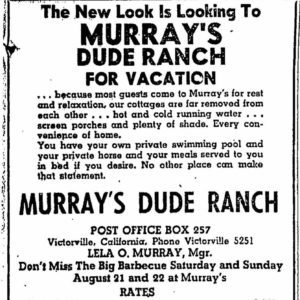APPLE VALLEY — Murray’s Dude Ranch was a guest ranch, celebrity get-away and desert oasis for Black travellers in the High Desert from the 1920’s to the 1960’s.
Nolie and Lela Murray, business owners from Los Angeles, bought the 40 acre land located where Waleew and Dale Evans Parkway cross in 1926 for $100.
The Murrays weren’t the first Black people in the area. The desert near Bell Mountain had been a gathering place for black homesteaders for close to a decade. It was Lela Murray’s respiratory problems that caused them to leave Los Angeles for the High Desert.
By the 1930’s 20 structures including cabins, a stable, the main house; tennis courts, a swimming pool, and a windmill to draw water from the 215 foot deep well had been built on the property.
RELATED: Boots from Apple Valley Dude Ranch on display at Academy Museum until April 2023
During this time widespread segregation practices limited Black Californians’ access to most private and public recreational facilities. Resorts, hotels, nightclubs, and even public parks in many California communities were closed to Black patrons.

It was in this landscape that the Murrays decided to launch their dude ranch as a desert oasis for the black families in the high desert.
In 1937, heavyweight champion Joe Louis visited the ranch with photographers from Life Magazine. Aside from Louis who returned to the ranch on several occasions, other visitors included singer Lena Horne, actress Nina Mae McKinney, architect Paul Williams, and actor Clark Gable. A series of negro westerns were filmed at the Murray Ranch including The Bronze Buckaroo starring Herb Jeffries.
After Lela Murray’s death in 1949, Nolie eventually sold off most of the ranch to actress and singer Pearl Bailey. The actress and her husband kept the place for a decade before selling it off. By 1988, the ranch had been abandoned for some years and unfounded rumors of a brown recluse spider prompted the owners to ask the Apple Valley Fire Department to use the remaining buildings for training. They were burned down shortly thereafter.
Although the remains of the ranch are scarce, its memory will live on through the photos and films that captured the essence of Black people in the West during the 1930’s and 40’s.
Sources:
Clarke, Chris. “African-Americans Shaping the California Desert: Murray’s Ranch.” KCET, 15 February 2012. https://www.kcet.org/socal-focus/african-americans-shaping-the-california-desert-murrays-ranch
Thompson, Richard D. “Murray’s Ranch: Apple Valley’s African-American Dude Ranch.” http://mojavehistory.com/murray1.html

